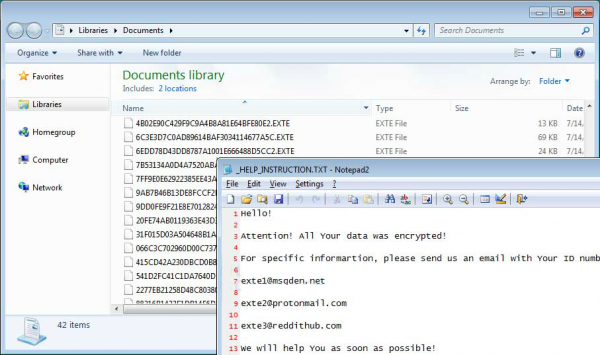CryptoMix encryption now adds the following to the names of affected items: .EXTE. This extra extension marks another spinoff in the ransomware family.

The encryption by this variant of CryptoMix also modifies main part of a file name. To be precise, the filename undergoes severe encryption to become a random sequence of digits. No likely means can process such a sequence back to the original, expect the decryptor held by the crooks.
.EXTE is, in general, true to the behavior and type of its family. There are some differences to note, though. First, pay attention to its ransom note: _HELP_INSTRUCTION.TXT. It contains a message that indicates the following emails as contacts: [email protected], [email protected], or [email protected]. The victims are supposed to write a message to one of those addresses. In response, they are to receive the respective payment instructions. The emails are unique as they do not occur in other versions of CryptoMix.
Infection vectors that propagate the ransomware are rather a heritage of its family. The ransomware leverages spamming, including target campaigns. The spam message tends to mention personal and private details of the recipients. It may also originate from a trusted contact. Such contact is thus a compromised account. This throws the users off their guard.
EXTE virus installation does not require any further human interaction. It may, however, interact with other running processes in such a way that system and software may freeze.
A complete installation generates a report sent to the remote server. The server does not need to reply as the encryption routine is embedded into the body of EXTE vile virus. The ransomware scrambles data with a public key. There are only 10 such keys as of now. To decrypt the data hit by .EXTE file virus, you need a private key, which is a unique value. A brute-force cannot compute the private key. The extortionists demand that you transfer them some bitcoins. The exact amount varies greatly and may reach thousands of USD.
Paying the ransom does not ensure the decryptor release, yet provides further incentives to the scammers. The free guidance below is a good chance to get rid of .EXTE encryption and enhance the overall system and data security.
Automatic removal of EXTE ransomware
The benefits of using the automatic security suite to get rid of this infection are obvious: it scans the entire system and detects all potential fragments of the virus, so you are a few mouse clicks away from a complete fix.
- Download and install recommended malware security suite
- Select Start Computer Scan feature and wait until the utility comes up with the scan report. Proceed by clicking on the Fix Threats button, which will trigger a thorough removal process to address all the malware issues compromising your computer and your privacy.
Restore files locked by EXTE virus
EXTE virus represents a unique category of malicious software whose attack surface reaches beyond the operating system and its components, which is why removing the virus itself is a part of the fix only. As it has been mentioned, it encrypts one’s personal information, so the next phase of the overall remediation presupposes reinstating the files that will otherwise remain inaccessible.
-
Launch data recovery software
Similarly to the rest of its fellow-infections, EXTE most likely follows an operational algorithm where it erases the original versions of the victim’s files and actually encrypts their copies. This peculiarity might make your day, because forensics-focused applications like Data Recovery Pro are capable of restoring the information that has been removed. As the virus further evolves, its modus operandi may be altered – in the meanwhile, go ahead and try this.
-
Take advantage of Volume Shadow Copy Service
This technique is based on using the native backup functionality that’s shipped with Windows operating system. Also referred to as Volume Snapshot Service (VSS), this feature makes regular backups of the user’s files and keeps their most recent versions as long as System Restore is on. EXTE virus hasn’t been found to affect these copies therefore the restoration vector in question is strongly recommended. The two sub-sections below highlight the automatic and manual workflow.
- a) Use Shadow Explorer
Shadow Explorer is an applet that provides an easy way of retrieving previous versions of files and folders. Its pro’s include an intuitive interface where the computer’s entire file hierarchy is displayed within one window. Just pick the hard disk volume, select the object or directory to be restored, right-click on it and choose Export. Follow the app’s prompts to get the job done.

- b) Use file properties
Essentially, what the above-mentioned Shadow Explorer tool does is it automates the process that can otherwise be performed manually via the Properties dialog for individual files. This particular approach is more cumbrous but just as effective as its software-based counterpart, so you can proceed by right-clicking on a specific file, which has been encrypted by EXTE ransomware, and selecting Properties in the context menu. The tab named Previous Versions is the next thing to click – it displays available versions of the file by date of the snapshot creation. Pick the latest copy and complete the retrieval by following the prompts.

-
Data backups work wonders
Ransomware like EXTE isn’t nearly as almighty and destructive in case you run regular file backups to the cloud or external data media. The virus itself can be completely removed in a matter of minutes, and the distorted information can then be just as easily recovered from the backup. Luckily, this is a growing trend, so ransom Trojans are hopefully going to become less subversive in the near future.
Verify thoroughness of the removal
Having carried out the instructions above, add a finishing touch to the security procedure by running an additional computer scan to check for residual malware activity
